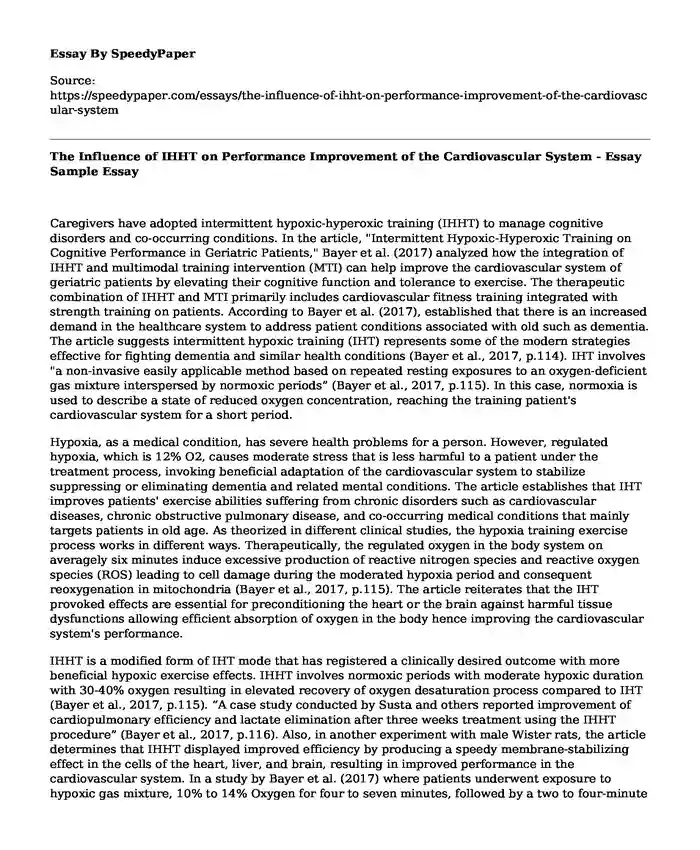
| Type of paper: | Essay |
| Categories: | Medicine Healthcare |
| Pages: | 3 |
| Wordcount: | 623 words |
Caregivers have adopted intermittent hypoxic-hyperoxic training (IHHT) to manage cognitive disorders and co-occurring conditions. In the article, "Intermittent Hypoxic-Hyperoxic Training on Cognitive Performance in Geriatric Patients," Bayer et al. (2017) analyzed how the integration of IHHT and multimodal training intervention (MTI) can help improve the cardiovascular system of geriatric patients by elevating their cognitive function and tolerance to exercise. The therapeutic combination of IHHT and MTI primarily includes cardiovascular fitness training integrated with strength training on patients. According to Bayer et al. (2017), established that there is an increased demand in the healthcare system to address patient conditions associated with old such as dementia. The article suggests intermittent hypoxic training (IHT) represents some of the modern strategies effective for fighting dementia and similar health conditions (Bayer et al., 2017, p.114). IHT involves "a non-invasive easily applicable method based on repeated resting exposures to an oxygen-deficient gas mixture interspersed by normoxic periods” (Bayer et al., 2017, p.115). In this case, normoxia is used to describe a state of reduced oxygen concentration, reaching the training patient's cardiovascular system for a short period.
Hypoxia, as a medical condition, has severe health problems for a person. However, regulated hypoxia, which is 12% O2, causes moderate stress that is less harmful to a patient under the treatment process, invoking beneficial adaptation of the cardiovascular system to stabilize suppressing or eliminating dementia and related mental conditions. The article establishes that IHT improves patients' exercise abilities suffering from chronic disorders such as cardiovascular diseases, chronic obstructive pulmonary disease, and co-occurring medical conditions that mainly targets patients in old age. As theorized in different clinical studies, the hypoxia training exercise process works in different ways. Therapeutically, the regulated oxygen in the body system on averagely six minutes induce excessive production of reactive nitrogen species and reactive oxygen species (ROS) leading to cell damage during the moderated hypoxia period and consequent reoxygenation in mitochondria (Bayer et al., 2017, p.115). The article reiterates that the IHT provoked effects are essential for preconditioning the heart or the brain against harmful tissue dysfunctions allowing efficient absorption of oxygen in the body hence improving the cardiovascular system's performance.
IHHT is a modified form of IHT mode that has registered a clinically desired outcome with more beneficial hypoxic exercise effects. IHHT involves normoxic periods with moderate hypoxic duration with 30-40% oxygen resulting in elevated recovery of oxygen desaturation process compared to IHT (Bayer et al., 2017, p.115). “A case study conducted by Susta and others reported improvement of cardiopulmonary efficiency and lactate elimination after three weeks treatment using the IHHT procedure” (Bayer et al., 2017, p.116). Also, in another experiment with male Wister rats, the article determines that IHHT displayed improved efficiency by producing a speedy membrane-stabilizing effect in the cells of the heart, liver, and brain, resulting in improved performance in the cardiovascular system. In a study by Bayer et al. (2017) where patients underwent exposure to hypoxic gas mixture, 10% to 14% Oxygen for four to seven minutes, followed by a two to four-minute direction of hyperoxic gas mixture, 30% to 40% O2 showed the benefits obtained from IHHT procedure (p.118). After the IHHT procedure, the patients showed increased functional exercise capacity and pain tolerance capabilities, which are indications of an improved performing cardiovascular system. The results of these tests showed enhanced exercise tolerance by patients suffering from chronic health conditions. Therefore, the article's theoretical and empirical research determines that IHHT as a treatment procedure can improve a patient's cardiovascular system's efficiency to withstand exercise and pain.
Reference
Bayer, U., Likar, R., Pinter, G., Stettner, H., Demschar, S., Trummer, B., Neuwersch, S., Glazachev, O. and Burtscher, M., 2017. Intermittent hypoxic–hyperoxic training on cognitive performance in geriatric patients. Alzheimer's & Dementia: Translational Research & Clinical Interventions, 3(1), pp.114-122. https://doi.org/10.1016/j.trci.2017.01.002
Cite this page
The Influence of IHHT on Performance Improvement of the Cardiovascular System - Essay Sample. (2024, Jan 24). Retrieved from https://speedypaper.net/essays/the-influence-of-ihht-on-performance-improvement-of-the-cardiovascular-system
Request Removal
If you are the original author of this essay and no longer wish to have it published on the SpeedyPaper website, please click below to request its removal:
- Free Paper With Annotated Bibliography on Diabetes
- Free Essay. a Successful Drug Abuse Recovery Program
- Free Essay: The Most Important Piece From the Students' Experiences
- Essay Example: Research on Nursing Grand Rounds
- Essay Sample on The Global Health Challenge of Tuberculosis in Malawi
- Laws & Regulations Impacting Healthcare Orgs: A Comprehensive Guide - Essay Sample
- Ethic Assessment Discussion - Essay Sample
Popular categories




